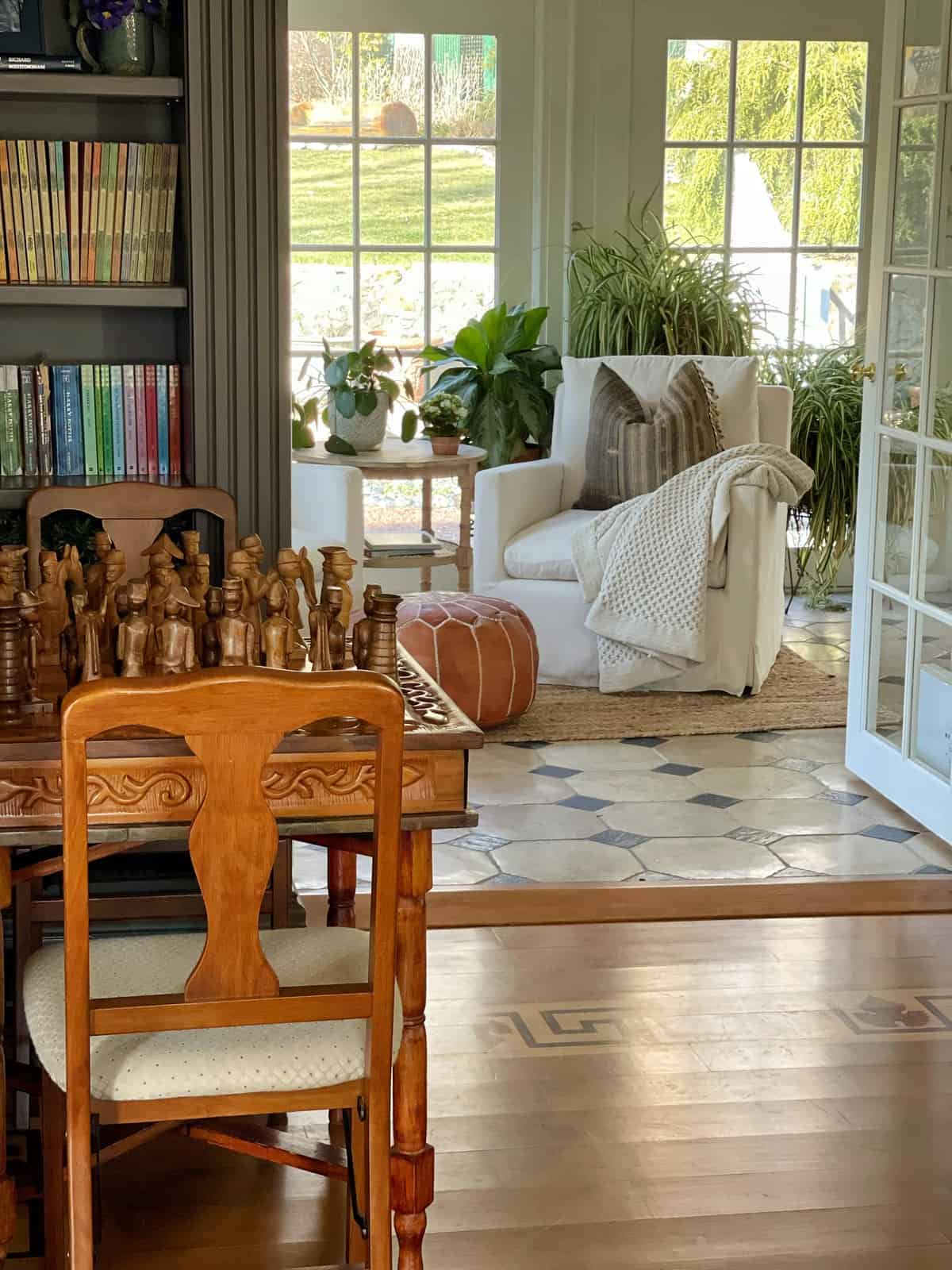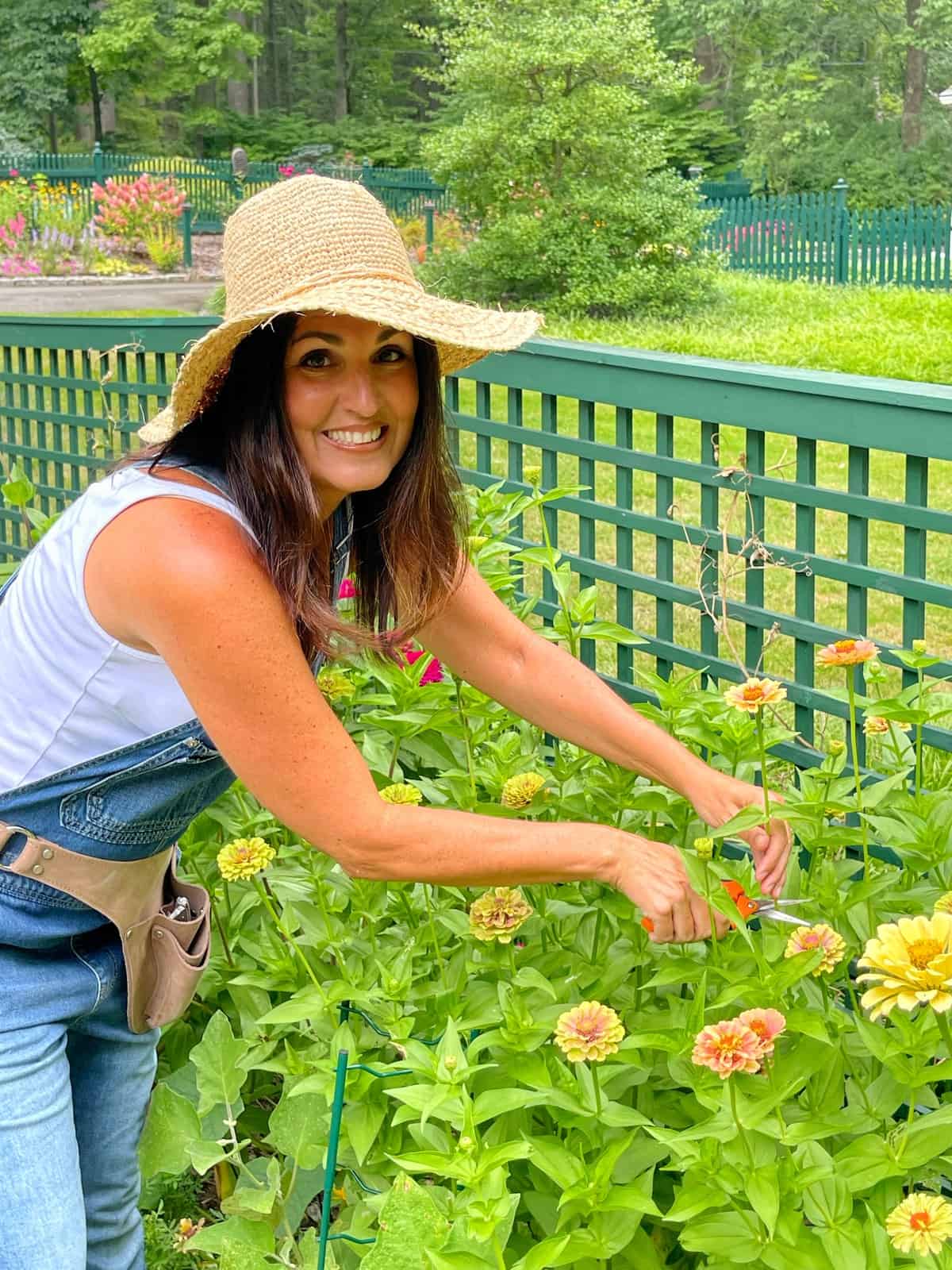Looking for an easy indoor plant that’s fun to grow? Try growing Chlorophytum Comosum. Unearth the secrets to lush, cascading spider plants with minimal effort! This foolproof guide shares everything you need to know for vibrant growth, how to avoid brown tips, and ways to keep your spiderettes thriving. Follow these tips for spider plant care.
Spider plants are popular houseplants that are so easy to grow, you don’t need a green thumb to care for them. In fact, spider plant care is simple to do. The plant can handle a range of light conditions, clean the air we breathe and is pretty resilient too making them no-fail to grow.
Spider plants propagate with ease so you can grow your own stock or make a great gift for friends and family. They are a great addition to any houseplant collection and I highly recommend growing one if you are new to indoor gardening or think you kill things.
I’ve had my spider plant for at least 10 years now. And since growing them, I’ve created lots of new plants from that one mother plant.
And because they are so easy to care for? I maintain them in several spaces throughout our home.
Want to learn more?
Wait until you see how easy spider plants are to grow and care for.
(Posts on stacyling.com may contain affiliate links. Click HERE for full disclosure.)
About Spider Plants
Spider Plants (Chlorophytum Comosum) are popular, easy-to-grow, and low-maintenance indoor plants. It is named for its long, spider-like leaves that grow from the plant’s center.
Mature spider plants produce small white or yellow flowers on long stems and offsets (baby spider plants) that can be rooted to create new spider plants.
It is well known for its air-purifying properties because it absorbs chemicals including formaldehyde, xylene, benzene, and carbon monoxide.

How to Grow Spider Plant
While spider plant care is relatively simple to do, here are some tips to keep in mind so you grow a healthy spider plant for years to come.
The foliage is really long and elegant. A mature plant might grow 36″ tall and 20″ wide (including the container) so give them room to grow inside. And I recommend using a plant stand or hang them with macrame pot holders because of the foliage length and allowing space for the babies to grow.
It’s a moderate to fast-growing indoor plant depending on the growing conditions. I bring mine outdoors to summer in New Jersey every season and it puts on the most growth during its summer vacation.

Light
Spider plants are really adaptable as far as their light requirements are concerned. In general, they prefer medium to bright indirect sunlight. But avoid direct sunlight which can scorch the leaves.
South-facing windows are a good spot to maintain them. I grew my spider plants in front of our south-facing windows for years.
Just make sure it’s not a hot window where the foliage will scorch. I live in New Jersey where we get a range of seasons and temperatures.
In our former home, I kept mine in south-facing windows during fall (after the first frost) until I moved it outside to summer outdoors.
In our current home, they are maintained in the sunroom which is on the north side of our home. Since there are large windows on 3 sides of the plant room, they are doing quite well and look pretty good even during winter dormancy.
I’ll move them outside to the back porch when all danger of frost has passed. And my spider plants will get a lot of healthy growth during their summer vacation.

Water
Water spider plants regularly, but allow the water to drain out. It’s important to let them dry out between waterings too so the soil doesn’t become waterlogged.
When spider plants are overwatered, they are more susceptible to pest and disease problems, so instead of watering on the same day every week, check the soil before watering.
Before watering, check 1-2″ down into the soil. If it’s dry, it’s time to water. To determine whether the soil is dry you can either use your finger, a plastic knife, popsicle stick, or a moisture meter like this one.
Soil
Use well-draining potting soil and ensure adequate drainage by using a container with a drainage hole.

Fertilizer
Fertilize during the growing season (spring and summer) with a balanced, slow-release fertilizer like this. It is a set-and-forget approach to fertilizing that makes it much easier to feed them.
Stop fertilizing in the fall and allow the plant to go dormant during the winter months.
Overfertilizing spider plants may decrease the number of spiderettes. And too much fertilizer may cause the foliage tips to brown.
Temperature
Spider plants prefer temperatures between 60-75°F (15-24°C), and can tolerate lower temperatures but not below 50°F (10°C).
This is important to know in case you bring your plants outdoors for summer vacation. I start bringing my houseplants back inside when the temperatures start to dip below 50 overnight (or sooner).

Humidity
Spider plants prefer moderate humidity but can adapt to a range of conditions.
During winter months when humidity is low, you can bump it up using a humidifier or grouping several houseplants together to create a more humid microclimate.
Repotting
They grow best and produce more spider babies when slightly pot-bound. Because they grow quickly and the roots can easily become too crowded, spider plants require frequent repotting.
So it’s a good idea, to repot every 2-3 years or as needed in a new container to provide adequate space for the roots to grow.
Shop for Pots
5 Benefits of Growing Spider Plants
If you are interested in expanding your houseplant collection with more easy-care plants, look no further than the spider plant.
Here are 5 reasons you should grow them.

Spider Plants Help Purify the Air
Studies have shown that spider plants purify the air we breathe by absorbing chemicals like formaldehyde, xylene, benzene, and carbon monoxide, making them a great choice for improving indoor air quality.
And since they are easy to propagate too, one plant goes a long way because, through the years, you can add to your collection without spending a dime.
Low Maintenance Indoor Plant
Spider plant care is easy to do as the plant can handle a variety of indoor growing conditions. And because they are easy to grow, they are a great choice for beginners, those who think they kill plants or those with busier schedules.

Versatile
Spider plants are very versatile too. They can be grown in pots, hanging baskets, or as ground cover (depending on where you live), making them a great option for any indoor or outdoor space.
Easy to Propagate
Spider plants produce offsets or baby spider plants, that can be easily rooted to create new plants, making them a great choice for gardeners who want to expand their collection.
Because they propagate with ease, they are a great budget-friendly way to grow your indoor plant collection. And they make a great gift idea for birthdays or the holidays, even if the recipient lacks a green thumb.
Gorgeous Houseplants
Spider plants have an incredible aesthetic appeal that can’t be rivaled. With their long, lush leaves and delicate white or yellow flowers, spider plants are a stylish and attractive addition to any indoor or outdoor space.

Pest and Disease Problems
Spider plants are generally easy to care for and are not prone to many pest and disease problems. Under or overwatering, mealy bugs, and spider mites cause the most problems.
As far as pest problems go, whiteflies, spider mites, scales, and aphids are the most common. In all the years I’ve grown mine, I’ve not had any of these issues. Avoid overwatering and pot plants in a soilless medium or well-draining potting soil.
Foliage tip burn is a common problem that can happen for a few reasons:
- Low humidity
- Excessively dry soil
- Salt accumulation
- Too much fluoride or chlorine in tap water
For best results, use distilled water or rainwater to help prevent brown tips. And keep in mind that overwatering or not using well draining soil can lead to root rot.

Spider Plant Propagation Methods
Spider plants are easy to propagate, and there are several methods you can use to expand your collection.
If you are new to propagating plants, the spider plant is an easy one to get your feet wet on.
Propagation by Baby Plants
Spider plants produce small plantlets called spiderettes which can be easily propagated by potting them up and giving them time to root.
And to me, this is the easiest way to propagate spider plants.
I’ve propagated several spider plants this way, and it couldn’t be easier to do.
Baby Spider Plant Propagation Directions
Here’s what you need to do.
- Look for offsets, or small spider plant babies, growing from mature plants and gently remove them with a sharp, clean knife or scissors.
- Fill a small pot with well-draining soil and plant the offset, making sure to cover the roots and the cut end.
- Water the offset thoroughly and place it in a bright, warm location, in indirect light.
- Water well but allow it to dry out between waterings.
In a few weeks, new growth should emerge and roots should establish. You’ll know the plant is rooted when you give a gentle tug and feel some resistance.

Propagation by Stolon Method
Set the mother plant next to a smaller container filled with well-draining potting soil. Find a baby spiderette and plant it in the adjacent smaller container until it roots.
Maintain the moisture but don’t waterlog the baby plant. After the plant roots, cut the stem from the mother plant.
Spider Plant Propagation by Water
Similar to propagating the baby plants directly in the soil, you can also drop them in a mason jar of water until they root and plant them after.
Baby plants can be grown in water for a while, but you’ll need to keep the water clean by changing it out once a week.

Water Propagation Method Directions
While there are a few different methods for propagating, growing a spider plant in water is another easy way to expand your spider plant collection.
Propagating spider plants using the water method develops the plant roots first before planting them in soil.
Here’s how to do it.
- Fill a mason jar or vase with fresh clean water. But give it about an hour for the water to come to room temperature and dechlorinate before dropping your baby spider plant in.
- Cut a healthy and mature spider plant stem that has a spiderette with a pair of scissors or garden snips. Leave a few inches of the stolon.
- Drop the spiderette in the jar but don’t allow any leaves to sit in the water.
- Move the jar with your new spider plant to a location with indirect sunlight.
- Change the water when it gets murky and give it some time for roots to form. When you have a good grouping of roots, remove the new spider plant from the water.
- When the roots are about 2-3 inches long, you can transfer the spider plant to a pot with an indoor potting mix that is well-draining. Gently remove the stem from the water and plant it in well-drained soil, covering the roots completely.
- Water the soil and keep it in bright indirect sunlight.
Over time, the new spider plant will start to grow and produce new shoots and leaves within a few weeks.

Propagation by Division
This method involves dividing the mother plant into several smaller plants.
Carefully remove the plant from its pot and gently separate the roots into smaller sections, making sure each section has some leaves and roots. Repot the divided sections into their own pots with fresh potting soil that is well draining and water regularly.
Because other propagation methods are much easier and less messy, I suggest only doing it this way when you are repotting the plant and making a mess anyway.

More About Spider Plants
Have you grown a spider plant before? And if not, will you try growing one now? I would love to know more in the comments below.
And don’t miss joining my Gardening DIY and Decorating Community on Facebook for more chatter. And follow along there and on Instagram as well. There are behind the scenes daily things that I share on Instagram that don’t make it on the blog. Would love to see you there too!
If you prefer to binge watch Bricks ’n Blooms on TV, we go more in-depth with tours and posts on my YouTube channel. Would love to hang out with you there!
And… If you’re catching up on blog posts you may have missed, be sure to sign-up to get my newest posts via email to stay up to date with everything that’s happening here on the blog and more.
Shop For More Easy Houseplants
A must-have easy-care houseplant that produces red flowers. It's a great indoor plant for beginners.
A must-have houseplant that's easy to grow and blooms a few times per year.
A must-have easy-to-grow houseplant that is hard to kill if you tried! A great starter indoor plant for beginners.
A must-have easy-care houseplant that's hard to kill. Great indoor plant for beginners.
A must-have favorite easy-care houseplant, monstera deliciosa is no fuss to care for but visuall adds all the drama as part of your home decor.
Garden Supplies I Use
Since I’ve been gardening for well over twenty-five years, I’m often asked about the garden supplies and tools that I use most. Here are some of my favorites that I use in no particular order.
- I like to use a good-quality, potting soil, garden soil, compost, and perlite when planting. While I make my own compost, you can easily buy it ready-made for use.
- I have used this deer repellent with great success. But now, I’m all about this deer repellent that is systemic instead of topical. This means the plant takes it in as opposed to it just smelling bad. If you want to minimize the work and not use repellents, choose plants that are deer-resistant from this list.
- Hands down this is my favorite hand-weeding tool. You can use it to get underneath roots and loosen soil, and it cuts down on the weeding time because you work much faster.
- But I also love this long, stand-up weeding tool too.
- I use this organic fertilizer for roses because the blooms are more prolific and it’s organic.
- And I use this organic fertilizer for my vegetables and herbs.
- You’ll need a sharp set of pruners when working with plants and flowers. I buy a few so I can stash them around.
- I use these garden snips to deadhead and cut flowers.
- If necessary, I use this insecticidal soap or neem oil to help control infestations depending on the issue. When using, only apply when pollinators are less active.
- This is my go-to bait for slug and snail problems with my hostas and dahlias.
- This is my favorite set-and-forget slow-release fertilizer for houseplants, annuals, and container gardens.
- I use these grow-through garden supports for peonies, dahlias, and other plants with top-heavy blooms because they work really well and keep the blooms upright.
- I use this collapsible bin ALL THE TIME because it’s light to carry around and folds flat for easy storage.
- Drip irrigation set on a timer is your friend! I love these for my planters, window boxes, and hanging baskets.

Click here to shop my favorite garden supplies!
Shop for Planters


More Houseplant Care Tips and Tricks
- 7 Simple Ways to Keep Your Houseplants Alive
- How to Revive Plants to Save Them
- How to Style Your Houseplants
- Monstera Plants and Why You Should Grow One
- Pilea Plant Care
- Snake Plant Care
- Propagating Pothos Plant
- 7 Easy Indoor Gardening Ideas for Beginners
- What You Need to Know About Easy Care Houseplants that Purify the Air
- The Secret to Keeping Houseplants Alive
- How to Propagate Pothos Plant
- Have a Green Thumb With These Indoor Gardening Ideas
- Christmas Cactus Care
- Dividing an Aloe Plant
- Amaryllis Care
Sign Me Up!
Sign up for my free newsletter to get blog posts, seasonal tips, recipes, and more delivered straight to your inbox!
Plus, get free VIP access to my Resource Library where you’ll find insider freebies not readily available to the public.

My Latest Posts
Easy Baked Shrimp Scampi Recipe in 30 Minutes
Transform a Vintage Carriage into a Charming Front Porch Planter (Easy Thrift Flip)
Finding Hidden Gems: My Top Thrifting Tips to Spruce Up Your Garden on a Budget
Thrifting for the Garden: Tips to Find Unique & Affordable Decor
Unique Thrift Store Finds for Your Garden
Bricks ‘n Blooms Weekly 181
Thank you so much for following along.
Enjoy a beautiful day! xo

About Me
Want to learn more about me? I’m a master gardener who’s been gardening and growing things for over 25 years and author of the best-selling book, The Bricks ‘n Blooms Guide to a Beautiful and Easy-Care Flower Garden. Get the inside scoop about my background as a master gardener, education, and experience, as well as why I started blogging here.

Let’s Connect!
If you like this post, please follow me @bricksnblooms on Pinterest, Facebook, Instagram, and TikTok. Subscribe to my YouTube Channel. Or join my Facebook Group.














